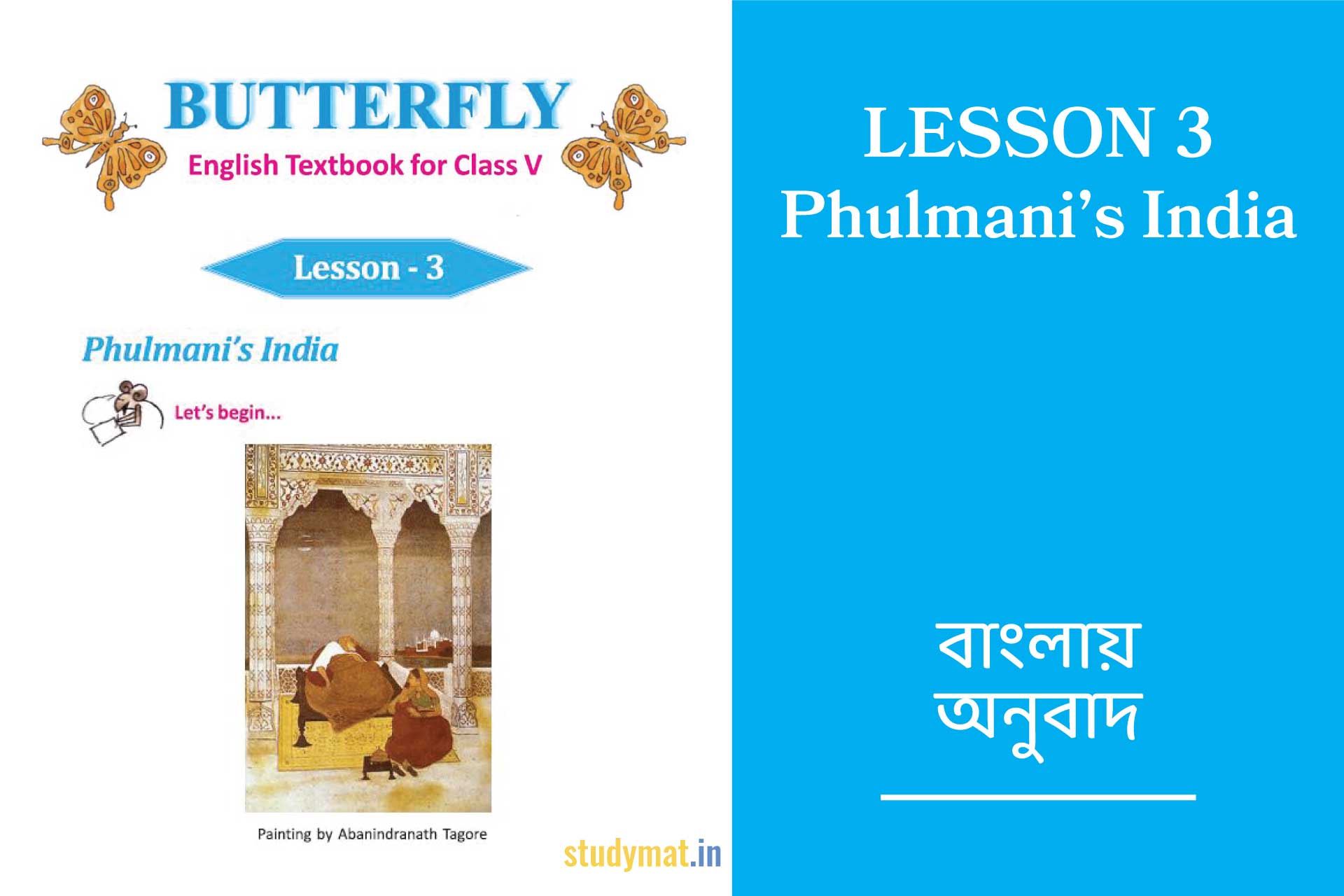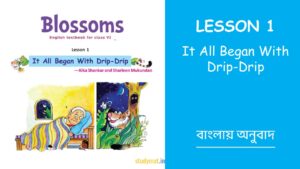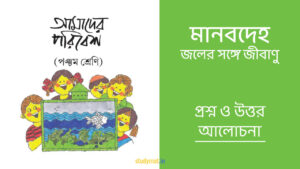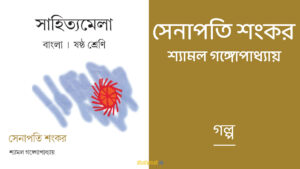“Butterfly” is the English textbook for class 5 approved by the West Bengal Board of Primary Education (WBBPE). You are in the right place if you are looking for Lesson 3, Phulmani’s India – Bengali Translation line by line.
PHULMANI’S INDIA – BENGALI TRANSLATION | বাংলায় অনুবাদ
Phulmani is a Santhal girl. She lives in a village. Have you ever been to her house? There are beautiful pictures painted on the walls of her house. All her neighbours have painted on their doorways and interiors. There are pictures of trees, flowers and birds on the walls and floors. Phulmani, like her elders, loves to paint on the mud walls. The pictures of hers are colourful. Her teachers told her that even in ancient India, people used to paint inside the caves and on the rocks of hills. The rock paintings of Bhimbetka are more than twenty thousand years old. They are red, white, green or yellow in colour. Phulmani has never been to Bhimbetka to see the rock paintings of ancient men. But she has heard stories about the famous rock paintings from her teacher.
ফুলমণি একটি সাঁওতাল মেয়ে । সে একটি গ্রামে থাকে । তুমি কি কখনও তার বাড়িতে গিয়েছো ? তার বাড়ির দেওয়ালে সুন্দর ছবি আঁকা রয়েছে । তার সমস্ত প্রতিবেশীরা তাদের বাড়ির দরজায় এবং বাড়ির ভিতরে ছবি এঁকেছে । দেওয়াল এবং মেঝেতে গাছ, ফুল এবং পাখির ছবি রয়েছে । ফুলমণি, তার বাড়ির বড়দের মতো, মাটির দেয়ালে আঁকতে ভালোবাসে । তার আঁকা ছবিগুলো রঙিন । তার শিক্ষকরা তাকে বলেছিলেন যে প্রাচীন ভারতেও, লোকেরা গুহার ভেতরে এবং পাহাড়ের পাথরের গায়ে ছবি আঁকতো । ভীমবেটকার রক পেইন্টিংগুলো কুড়ি হাজার বছরেরও বেশি পুরোনো । এগুলো হল লাল, সাদা, সবুজ বা হলুদ রঙের । ফুলমণি কখনও ভীমবেটকায় প্রাচীন পুরুষদের রক পেইন্টিং দেখতে যায়নি । তবে সে তার শিক্ষকের কাছ থেকে বিখ্যাত রক পেন্টিংয়ের গল্প শুনেছে ।
Read Also:
Revision Lesson – Bengali Translation | Class 5 | Butterfly
India : Superpower in Cricket | Lesson 1 | Bengali Translation | Class 5 | Butterfly
A Feat on Feet | Lesson 2 | Bengali Translation | Class 5 | Butterfly
One day, her teacher showed her a picture. She came to know that it was the picture of a very famous cave painting of our country. Do you want to see that painting? Here it is:
একদিন, তার শিক্ষক তাকে একটি ছবি দেখিয়েছিলেন । সে জানতে পেরেছিল যে এটি আমাদের দেশের একটি খুব বিখ্যাত গুহাচিত্রের ছবি । তুমি কি সেই চিত্রটি দেখতে চাও ? এটা এখানে :
This is one of the paintings found in the Ajanta caves. It is a fresco. Almost two thousand years ago, some great Indian artists painted inside the caves of Ajanta and Ellora. Our country is the home to many religions. Hinduism, Buddhism and Jainism appear together in the sculptures of Ellora. Down the ages many great artists painted inside many other temples and churches of our country.
এটি অজন্তা গুহায় পাওয়া চিত্রগুলির মধ্যে আঁকা একটি চিত্র । এটি একটি দেওয়াল চিত্র । প্রায় দুই হাজার বছর আগে, অজন্তা ও ইলোরার গুহাগুলির ভেতরে কিছু মহান ভারতীয় শিল্পীরা এঁকেছিলেন । আমাদের দেশ অনেক ধর্মের আবাসস্থল । ইলোরার ভাস্কর্যগুলিতে হিন্দু, বৌদ্ধ এবং জৈন ধর্ম একসঙ্গে দেখা যায় । যুগে যুগে অনেক মহান শিল্পীরা আমাদের দেশের আরও অনেক মন্দির এবং গীর্জার ভেতরে এঁকেছেন ।
Read Also:
Phulmani’s India | Lesson 3 | Question & Answer | Class 5 | Butterfly
Memory in Marble | Lesson 4 | Bengali Translation | Class 5 | Butterfly
Little Phulmani is surprised to know that many of the Indian dance forms started within the temples. Phulmani is a natural dancer. She loves to dance to the rhythm of the drum like all the other members of her community. Her teacher said that folk dance is a popular art form among the various communities of India. The Punjabis love the Bhangra dance. In the same way, Dandiya is popular in Gujrat, Bihu in Assam and Chhau in West Bengal. Phulmani loves to watch Chhau dance performed during festivals. The performers wear masks. They shake their heads and jump in the air in harmony with music. Phulmani always cries out in joy at the end of a Chhau dance performance.
ছোট্ট ফুলমণি অবাক হয়ে জেনেছে যে মন্দিরের মধ্যেই ভারতীয় নৃত্যের অনেকগুলির সূচনা হয়েছিল । ফুলমণি একজন সহজাত নৃত্যশিল্পী । সে তার সম্প্রদায়ের অন্যান্য সদস্যদের মতো ঢোলের তালে নৃত্য করতে ভালবাসে । তার শিক্ষক বলেছিলেন যে লোকনৃত্য ভারতের বিভিন্ন সম্প্রদায়ের মধ্যে একটি জনপ্রিয় শিল্প বিন্যাস । পাঞ্জাবীরা ভাংড়া নৃত্য ভালোবাসে । একইভাবে, ডান্ডিয়া জনপ্রিয় গুজরাটে, আসামে বিহু এবং পশ্চিমবঙ্গে ছৌ জনপ্রিয় । ফুলমণি উত্সব চলাকালীন ছৌ নৃত্য দেখতে ভালোবাসে । অভিনয়শিল্পীরা মুখোশ পরেন । তারা মাথা নাড়েন এবং সঙ্গীতের সাথে তাল মিলিয়ে বাতাসে লাফান । ছৌ নৃত্যের অনুষ্ঠান শেষে ফুলমণি সবসময় আনন্দে কেঁদে ওঠে ।
Read Also:
My School Days | Lesson 5 | Bengali Translation | Class 5 | Butterfly
The Clever Monkey | Lesson 6 | Bengali Translation | Class 5 | Butterfly
Last Sunday little Phulmani went to see a jatra with her parents. Phulmani was thrilled to see the jatra. The next day when she narrated the story of the performance to the class, her teacher said that jatra is actually a kind of folk theatre. This kind of theatre is performed under different names in different parts of our country. It is called tamasha in Maharashtra, nautanki in North India and jatra in Bengal. Most of these folk theatres are based on mythological incidents or characters.
গত রবিবার ছোট্ট ফুলমণি তার মা-বাবার সাথে একটি যাত্রা দেখতে গিয়েছিল । ফুলমণি যাত্রা দেখে রোমাঞ্চিত হয়েছিল । পরের দিন যখন সে ক্লাসের কাছে যাত্রার অভিনয়ের গল্পটি বর্ণনা করেছিল, তখন তাঁর শিক্ষক বলেছিলেন যে যাত্রা আসলে এক ধরনের লোকনাট্য । এই জাতীয় নাটক আমাদের দেশের বিভিন্ন অঞ্চলে বিভিন্ন নামে পরিবেশিত হয় । এটিকে মহারাষ্ট্রে তামাশা, উত্তর ভারতে নটঙ্কি এবং বাংলায় যাত্রা বলা হয় । এই লোকনাট্যগুলির বেশিরভাগই পৌরাণিক ঘটনা বা চরিত্রগুলির উপর ভিত্তি করে তৈরি ।
Read Also:
The Rebel Poet | Lesson 7 | Bengali Translation | Class 5 | Butterfly
Buildings to Remember | Lesson 8 | Bengali Translation | Class 5 | Butterfly
India has a rich heritage of classical dance. There are many classical dance forms, and each deals with some mythological narrative. The dancers wear colourful dresses and dance in harmony with music. Dramatics is an essential part of the Indian classical dance tradition. Kathak is a dance of North India, while Bharatnatyam, Mohiniattyam, Kuchipuri and Kathakali are all from South India. Manipuri and Odissi dance are dance forms of Eastern India. Such a wide variety of dance forms cannot be found anywhere else in the world.
ভারতের শাস্ত্রীয় নৃত্যে সম্পদশালী ঐতিহ্য রয়েছে । এখানে অনেক শাস্ত্রীয় নৃত্যের বিন্যাস রয়েছে এবং প্রত্যেকটি কিছু পৌরাণিক আখ্যান নিয়ে কাজ করে । নৃত্যশিল্পীরা রঙিন পোশাক পরেন এবং সঙ্গীতের সাথে তাল মিলিয়ে নৃত্য করেন । নাটকীয়তা ভারতীয় শাস্ত্রীয় নৃত্যে ঐতিহ্যের একটি অপরিহার্য অঙ্গ । কত্থক উত্তর ভারতের একটি নৃত্য, যেখানে ভারতনাট্যম, মোহিনিত্তিয়াম, কুচিপুরী এবং কথাকলি সবই দক্ষিণ ভারতের । মণিপুরী ও ওডিসি নৃত্য পূর্ব ভারতের নৃত্যের রূপ । এই জাতীয় নৃত্যের এত বৈচিত্র্য বিশ্বের আর কোথাও খুঁজে পাওয়া যায় না ।
Read Also:
The Bird’s Eye | Lesson 9 | Bengali Translation | Class 5 | Butterfly
A Great Social Reformer | Lesson 10 | Bengali Translation | Class 5 | Butterfly
Dance and music have always been integral to the Indian culture. Phulmani has a sweet voice. She believes that she can sing in harmony with musical instruments, like sitar, tabla, sarengi, drum, and so on. Phulmani came to know that the Indian kings and rulers patronised classical music and dance in their courts. Emperor Akbar loved to listen to the songs of Tansen. Our country is so big that we have many different styles of classical music like Hindustani and Carnatic. Each of these styles grew in temples and developed down the ages.
নৃত্য এবং সঙ্গীত সর্বদাই ভারতীয় সংস্কৃতির অবিচ্ছেদ্য অঙ্গ । ফুলমণির মধুর কণ্ঠস্বর রয়েছে । সে বিশ্বাস করে যে সেতার, তবলা, সারেঙ্গি, ঢোল ইত্যাদি বাদ্যযন্ত্রের সাথে তাল মিলিয়ে সে গান গাইতে পারে । ফুলমণি জানতে পেরেছিল যে ভারতীয় রাজারা এবং শাসকরা তাদের রাজসভায় শাস্ত্রীয় সঙ্গীত এবং নৃত্যের পৃষ্ঠপোষকতা করেছিলেন । সম্রাট আকবর তানসেনের সঙ্গীত শুনতে ভালোবাসতেন । আমাদের দেশ এত বড় যে আমাদের কাছে হিন্দুস্তানি এবং কর্ণাটিকের মতো শাস্ত্রীয় সঙ্গীতের বিভিন্ন শৈলী রয়েছে । এই শৈলীগুলির প্রত্যেকটি মন্দিরে উত্পত্তি লাভ করেছে এবং যুগে যুগে বিকশিত হয়েছে ।
Read Also:
The Finishing Point | Lesson 11 | Bengali Translation | Class 5 | Butterfly
Beyond Barriers | Lesson 12 | Bengali Translation | Class 5 | Butterfly
Phulmani is proud to be an Indian. She has heard that our country is full of great monuments, forts and wonderful architectures. She has seen the picture of the Taj Mahal. It is one of the seven wonders of the world. The fort at Agra and the Red fort in Delhi are also worth seeing. The huge gateway or Buland Darwaza, built by Emperor Akbar, at Fatepur Sikri is also among the monuments that Phulmani wishes to see. She hopes that some day she will be able to travel all over India and see all the fascinating monuments.
ফুলমণি একজন ভারতীয় হিসেবে গর্বিত । সে শুনেছে যে আমাদের দেশ মহান স্মৃতিস্তম্ভ, দুর্গ এবং বিস্ময়কর স্থাপত্যে পূর্ণ । সে তাজমহলের ছবি দেখেছে । এটি বিশ্বের সাতটি আশ্চর্যের মধ্যে একটি । আগ্রার দুর্গ এবং দিল্লির লালকেল্লাও দেখার মতো । ফতেপুর সিক্রিতে সম্রাট আকবর দ্বারা নির্মিত বিশাল গেটওয়ে বা বুলন্দ দরওয়াজাও সেই স্মৃতিস্তম্ভগুলির মধ্যে একটি যেগুলি ফুলমণি দেখতে ইচ্ছুক । সে আশা করে যে কোনও একদিন সে সারা ভারত ভ্রমণ করতে এবং সমস্ত আকর্ষণীয় স্মৃতিস্তম্ভ দেখতে সক্ষম হবে ।
So, hope you have found, Lesson 3, Phulmani’s India – Bengali Translation line by line helpful.
Follow us:
If you like this article, you can Follow us on Facebook.
Also, you can Subscribe to our YouTube Channel.




